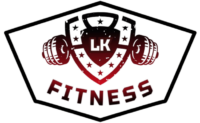A DEEP DIVE INTO ARMS TRAINING
Introduction
The Most Effective Guide to Bicep Training: Building Strong, Sculpted Arms
Introduction
When it comes to showcasing strength and physique, few muscles are as prominent and admired as the biceps. Located on the front of your upper arm, these muscles are not only key to many upper body movements but also a symbol of fitness and power. Whether you’re a beginner or a seasoned athlete, optimizing your bicep training can lead to impressive gains. Here’s a comprehensive guide to help you build stronger, more defined biceps.
Understanding Bicep Anatomy
The bicep muscle consists of two main parts:
- Biceps Brachii: This muscle has two heads – the Long head and the Short head. These heads work together to flex the elbow and supinate the forearm.
- Brachialis: Located underneath the biceps brachii, this muscle also plays a crucial role in elbow flexion and contributes to the arm’s overall size.

Benefits of Bicep Training
- Improved Aesthetics: Well-defined biceps enhance the overall look of your arms, contributing to a balanced and muscular appearance.
- Functional Strength: Strong biceps are essential for daily activities and various sports, aiding in movements like lifting, pulling, and carrying.
- Enhanced Upper Body Performance: Bicep training supports back compound exercises, such as pull-ups/chin-ups & rows, by providing greater pulling power and stability.
Effective Bicep Exercises
1. Standing Barbell Bicep Curl – A Fundamental Exercise For Building Strong Biceps.


How To Do It:
- Stand upright, hold a barbell with an underhand grip, with your hands shoulder-width apart.
- Curl the bar up towards your chest while keeping your elbows and shoulders stationary.
- Lower the bar down slowly in a controlled manner and fully extend your arms.
- Perform 3-4 sets of 12-15 reps.
Variations & Tips:
- Avoid swinging the weight to keep momentum down to a minimum, keep your core engaged at all times.
- You can perform this exercise with a straight bar as well as the EZ bar.
- Feel free to experiment with cable machine curls, set the pulley to the lowest position, attach the bar of your choice, and start curling.


2. Dumbbell Curl – Allows For A Greater Range Of Motion & Can be Performed Alternately Or Simultaneously.
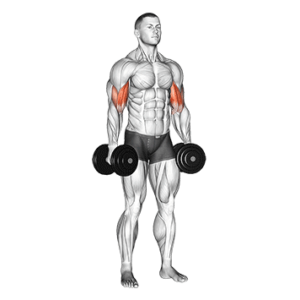

How To Do It:
- Hold a dumbbell in each hand with a neutral grip (Palms facing each other)
- Curl the weight towards your shoulders while keeping your elbows and shoulders stationary.
- Supinate your wrists while curling the weight on the way up to finish the first part of the repetition with your palms facing up.
- Lower the dumbbells down slowly in a controlled manner, and pronate your wrists back to the neutral position
- Perform 3-4 sets of 12-15 reps (Per arm).
3. Concentration Curl – Isolates Biceps For Maximum Engagement.


How To Do It:
- Sit on a bench, hold a dumbbell in one hand, and rest your elbow on the inside of your thigh.
- Curl the weight up towards your chest while keeping your shoulder stationary, your palm should be facing up.
- Lower the weight down in a controlled manner and fully extend your arm.
- Perform 12-15 reps for each arm, 3-4 sets in total.
4. Preacher Curl – Emphasizes The Lower Part Of The Biceps.


How To Do it:
- Use a preacher bench or a regular bench with an adjustable angle, 45-60% incline is ideal.
- Hold a dumbbell or a barbell with an underhand grip, your chest should be touching the top of the bench and your arms should be resting on the inclined surface as your starting position.
- Curl the weight up towards your shoulders and start lowering it as soon as the feeling of resistance disappears.
- Perform 3-4 sets of 12-15 reps.
Barbell Variation – Isolate Biceps Effectively


Machine Alternative – Isolate Biceps With Constant Pressure

5. Incline Dumbbell Bicep Curl – Provides Full Stretch And Full Contraction
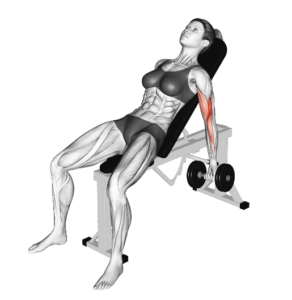
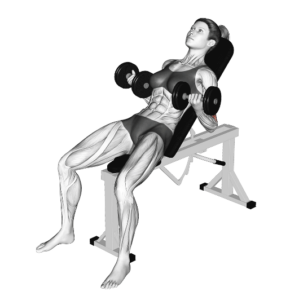
How To Do It:
- Adjust the bench to 60-75% Incline, and sit on the bench with your back against the backrest.
- Hold dumbbells in each hand with an underhand grip and have your arms fully extended as your starting position for maximum stretch.
- Curl dumbbells up towards your shoulders with your palms facing up.
- Lower them down slowly and extend your arms fully.
- Perform 3-4 sets of 12-15 reps.
Machine Alternative – Isolates Biceps


6. Crossover Machine Curl (Low Pulley) – Guarantees Maximum Stretch And Full Contraction With Constant Tension.


How To Do It:
- Attach single handles to each pulley and position both pulleys on the lowest setting.
- Select an appropriate weight for each side for your strength level.
- Grab the handles with an underhand grip (Palms facing up) and stand in the middle of the machine.
- Lean over forward and extend your arms fully, pulleys should be pulling your arms back.
- Curl the handles up while keeping your upper body stationary, pause, and squeeze your biceps for a second once you reach shoulder height.
- Lower the handles slowly back to the starting position
- Perform 3-4 sets of 12-15 reps.
7. Crossover Machine Curl (High Pulley) – Constant Tension & Peak Contraction


How To Do It:
- Set both pulleys to the highest position on each side of the cable crossover machine.
- Attach single handles to each pulley. Stand in the center of the machine and grip the handles with an underhand grip (palms facing up).
- Extend your arms to the sides of the body and keep your upper arms parallel to the floor.
- Keeping your upper arms stationary, curl the handles towards your head by bending your elbows.
- Squeeze your biceps for a brief moment when the muscle is fully contracted.
- Slowly extend your elbows back to the starting position
- Perform 3-4 sets of 10-12 repetitions.
Tips For Optimizing Bicep Workouts
- Proper Form: Ensure your form is correct to prevent injury and maximize muscle engagement. Avoid swinging the weights and keep your elbows close to your body.
- Progressive Overload: Gradually increase the weight or resistance to continuously challenge your muscles and promote growth.
- Mind-Muscle Connection: Focus on the contraction of the biceps during each rep to enhance muscle activation.
- Variety: Incorporate different exercises and angles to target all parts of the biceps effectively.
- Rest and Recovery: Allow adequate rest between bicep workouts to enable muscle repair and growth
Mastering Triceps Training: Tips for Building Massive & Well-Defined Arms
Introduction
The triceps ( Or triceps brachii ) muscle is located on the back of the upper arm and is responsible for extending the elbow joint. The triceps, composed of three distinct parts (Medial head, Lateral head & Long head), play a crucial role in pushing strength and aesthetics. Well-developed triceps are primary contributors to arm size. Whether you’re aiming to enhance your athletic performance, achieve a more sculpted look or simply increase the circumference of your arms – effective tricep workouts should be a staple in your fitness routine.
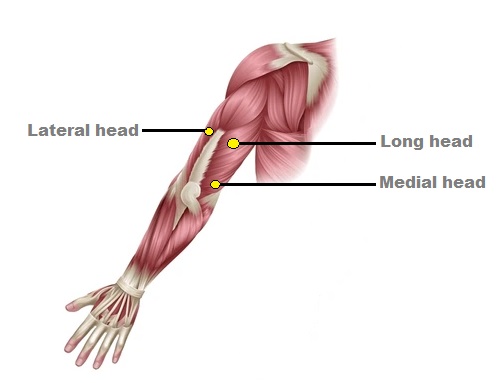
Importance of Tricep Training
Well-developed triceps contribute significantly to overall arm strength and stability. Strong triceps have a notable carryover effect on performance in pushing exercises such as Bench Press (Flat, Incline & Decline ) and Shoulder Press / Military Press.
Best Exercises for Triceps
1. Tricep Pushdowns – Isolates The Muscle, Great For Warming Up The Elbow Joint.


How To Do It:
- Stand facing a cable machine with a high pulley position, attach a rope handle to the pulley
- Stand upright, keep your back straight, and grab the rope on both ends.
- Keep your elbows to the sides of your body and start pushing the rope down.
- The starting position should be the following: Approximate angle between forearm and upper arm = 60-75%
- Maintain a stationary position of your shoulders & elbows, and fully extend your arms.
- Slowly allow the handle to rise back up, and control the weight on the way up to maintain constant tension on the muscle.
- Perform 3-4 sets of 12-15 repetitions.
2. Close-Grip Bench Press – The Tricep Mass Builder
This compound exercise targets the triceps along with the chest and shoulders. Use a narrower grip than usual to emphasize tricep engagement.


How To Do It:
- Lie flat on a bench press with your back firmly pressed against the bench.
- Grip the barbell with a close grip, slightly narrower than shoulder-width apart.
- Lift the barbell off the rack and hold it directly above your chest with your arms fully extended.
- Lower the barbell slowly and under control towards your lower chest. Keep your elbows tucked in & close to your body throughout the movement.
- Press the barbell back up to the starting position by extending your arms, but avoid aggressively locking out your elbows to avoid unnecessary strain or potential injury.
- Perform 3-4 sets of 12-15 reps.
3. Skull Crushers – One Of The Most Effective Exercises For Building Tricep Strength And Size.


How To Do It:
- Lie down on a bench (Either flat or a slight incline of your choice).
- Hold an EZ-curl bar or dumbbells with an overhand grip, hands shoulder-width apart.
- Extend your arms straight up toward the ceiling, holding the bar directly above your chest.
- Keeping your upper arms stationary and elbows tucked in, slowly lower the bar towards your forehead or behind your head.
- Engage your triceps to extend your elbows and bring the bar back to the starting position above your chest.
- Perform 3-4 sets of 12-15 reps.
Variations and Tips:
- Use different grip variations (e.g., EZ-curl bar, straight bar, dumbbells, or an overhead rope attachment on a cable machine) to target your triceps from different angles and make it easy on your wrists.
- Do not start your tricep training session with skull crushers to avoid unnecessary strain. It’s highly advised to do Tricep Pushdowns first in order to properly warm up and lubricate the elbow joint to prevent potential injury from occurring.
4. Tricep Dips – Dips Are Great Overall Upper Body Exercise That Targets Chest, Shoulders, And Triceps.

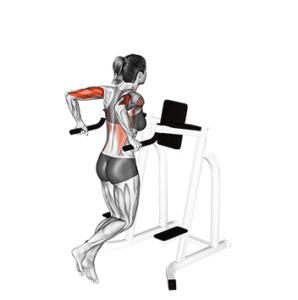
How To Do It:
- Grip the parallel bars of a dip station or a dip machine.
- Lift yourself up so your arms are straight. You can jump or use momentum to get into a starting position.
- Slowly lower your body until your elbows are at 90 degrees. Do not lean forward.
- Push back up to the starting position
- Perform 3-4 sets of 8-12 repetitions.
Tips:
- Start doing dips with your body weight only. If performing bodyweight dips is extremely challenging – start doing machine-assisted dips on a dip machine and incrementally lower the weight.
- Once you get comfortable with doing 12 repetitions with your body weight – feel free to start adding weight using specific belts or chains
- Do not lower yourself too deep while performing the descending part of the exercise to avoid potential shoulder / chest injury.
5. Tricep Dumbbell Extensions – Great Strength & Mass Builder Exercise With A Primary Focus On The Long Head.


How To Do It:
- Stand or sit on a bench with back support, holding a dumbbell with both hands overhead.
- Ensure your grip is secure and your palms are facing upwards, supporting the dumbbell from underneath.
- Extend your arms fully overhead, keeping your elbows close to your ears and your upper arms stationary.
- Lower the dumbbell behind your head by bending your elbows. Keep your upper arms still and maintain control throughout the movement.
- Contract your triceps to extend your elbows and lift the dumbbell back to the starting position.
- Perform 3-4 sets of 8-12 repetitions.
Variations and Tips:
- You can perform a single-arm version of dumbbell tricep extension which can be easier on shoulder joints and can result in better mind-muscle connection as you’re focusing on one arm at a time.


- Do not dive right into this exercise, make sure to properly warm up your shoulders and elbows before you do so.
6. Tricep Kickbacks – Great For A Warm Up, Isolates Triceps


How To Do It:
- Grab a relatively light dumbbell with one hand, and place the opposite knee on the bench for support.
- Hinge at the hips, lean forward, keep your lower back straight, and place your free hand on the bench, right in front of the knee.
- Hold the dumbbell close & to the side of your body with a neutral grip (Palm facing your body).
- Make sure your upper arm is parallel to the floor, extend your elbow straightening your arm behind you. Keep your upper arm stationary and move only your forearm.
- Slowly return to the starting position by bending your elbow, controlling the weight on the way down
- Switch sides and follow the same steps for the other arm.
- Perform 3-4 sets of 10-12 repetitions (On each arm).
Variations & Tips:
- It’s not necessary to use the bench for this exercise, you can do it standing as long you can lean over and maintain that body position without bench support.
- You can perform the same exercise on a cable machine. The cable machine provides tension throughout the movement, whereas during free-weight (Dumbbell) exercises you’re only working against gravity, therefore, tension on the muscle weakens and eventually disappears at the bottom.


Tips for Optimizing Tricep Workouts
Focus on Form: Proper form is crucial to prevent injury and maximize muscle engagement. Ensure controlled movements and avoid swinging or using momentum.
Progressive Overload: Continuously challenge your muscles by increasing weight, reps, or intensity. Gradual progression stimulates growth and strength development.
Variety is Key: Incorporate a variety of exercises to target all three heads of the triceps. Rotate between compound and isolation exercises to maintain balance and prevent plateauing.
Rest and Recovery: Allow adequate rest between workouts to promote muscle recovery and growth. Overtraining can hinder progress and increase the risk of injury.
Ultimate Guide to Building Popeye Forearms: Strengthen Your Grip and Build Muscle
Introduction
Are you looking to grow your forearms, build strength, improve your grip, and achieve better overall arm definition? Forearm exercises are essential for anyone aiming to enhance their upper body strength and muscular endurance. Whether you’re a weightlifter, rock climber, or simply want to improve your functional fitness, focusing on your forearms can yield significant benefits. In this comprehensive guide, we’ll explore the best forearm exercises, their benefits, and how to integrate them into your workout routine for optimal results.
The forearm consists of many small muscles with complex Latin names, but we can group them based on their primary functions: Brachioradialis (Elbow flexion), Pronator (Wrist pronation), Wrist flexors, and Wrist extensors.

Why Forearm Exercises Are Important
Strong forearms contribute to overall arm strength, improve grip, and enhance performance in various sports and daily activities. Here are some key benefits:
- Improved Grip Strength: Crucial for weightlifting, rock climbing, and other activities requiring strong fingers and exceptional pinching & squeezing power.
- Injury Prevention: Strengthening the forearms can help prevent injuries such as tennis elbow.
- Enhanced Aesthetics: Well-developed forearms contribute to a balanced and muscular appearance.
- Better Performance: Strong forearms improve your overall performance in the gym, for example, back muscles are known to be much stronger than forearms, therefore, forearms tend to get exhausted faster while performing back exercises with appropriate weight, since you’re actively gripping the bar or a handle to prevent the weight from slipping out of your hands.
Best Forearm Exercises
1. Dumbbell Wrist Curls – One Of The Main Forearm Mass Builders, Wrist Strengthener
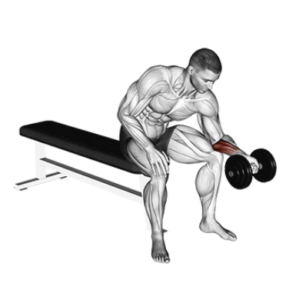
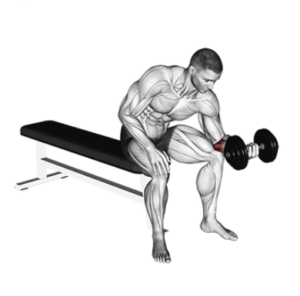
How to Do It:
- Sit on a bench with a dumbbell in each hand.
- Rest your forearms on your thighs with your wrists hanging over the edge, palms facing up.
- Curl the dumbbells upward by flexing your wrists.
- Lower the dumbbells back to the starting position in a controlled manner.
- Perform 3-4 sets of 12-15 reps.
Tips & Variations:
- Ensure controlled movements to maximize muscle engagement and reduce the risk of wrist injury.
- Feel free to perform a single-hand variation of this exercise, which allows you to focus on one forearm at a time.
- Some people prefer barbell wrist curls, but beginners might encounter issues with this exercise. Typically, one arm is stronger than the other, therefore, the stronger one tends to take over and do most of the workload, and consequently, further exacerbate muscle imbalance. It’s highly advised for beginners to work each forearm independently.


2. Reverse Wrist Curl – The Outer Forearm Builder
Targets Brachioradialis and Wrist extensors, essential for balanced forearm development & injury prevention

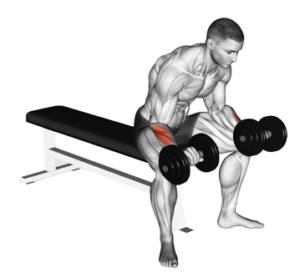
How to Do It:
- Sit on a bench with a dumbbell in each hand.
- Rest your forearms on your thighs with your wrists hanging over the edge, palms facing down.
- Extend your wrists to lift the dumbbells upward.
- Lower the dumbbells back to the starting position slowly.
- Perform 3-4 sets of 12-15 reps.
Tips & Variations:
- Keep your movements steady to focus on the extensor muscles of the forearm.
- Forearm extensor muscles, by default, are significantly weaker than forearm flexors so it’s perfectly normal to use much lighter weights in this exercise as opposed to wrist curls.
- Similarly to wrist curls, reverse wrist curls can also be performed with the barbell, but beginners might encounter similar issues with one of the arms being stronger than the other, so, once again, prioritize working each arm independently, and make sure to perform the same amount of repetitions on both arms.


3. Hammer Curls
Targets Brachioradialis, Brachialis, Biceps


How to Do it:
- Stand upright with your shoulders back, hold dumbbells in each hand, and let your arms hang by your sides.
- Keep your elbows close to your torso and curl the weight up while maintaining a neutral grip (Palms facing each other).
- Perform the full range of motion, fully extend your arm on the way down, and fully contract your elbow joint on the way up.
- Perform 3-4 sets of 12-15 reps.
Tip:
Keep it slow and steady, shoulders – stationary. Avoid swinging the weight to keep momentum down to a minimum.
4. Reverse Barbell Curls (Ez-Bar) – Great For Building Brachioradialis


How To Do It:
- Stand upright and grab the EZ bar with an overhand grip (palms facing down), hands shoulder-width apart.
- Keeping your elbows close to your sides, curl the bar up towards your shoulders.
- When the bar reaches shoulder level, squeeze your biceps and forearms for a moment.
- Slowly lower the bar back to the starting position by extending your elbows. Maintain control throughout the movement.
- Make sure to move only your forearms; your upper arms should remain stationary throughout the movement.
- Perform 3-4 sets of 10-12 repetitions.
5. Farmer’s Walk – Great For Developing Grip Strength And Building Forearm Flexors
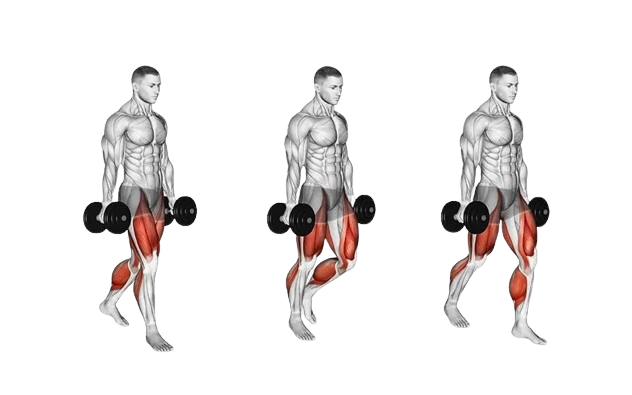
How to Do It:
- Hold a heavy dumbbell or kettlebell in each hand.
- Stand upright with your shoulders back and core engaged.
- Walk a set distance (e.g., 30-50 meters) while maintaining a firm grip.
- Rest and repeat for 3 sets.
Tip & Additional Information:
- Choose a weight that challenges your grip without compromising your posture.
- Farmer’s Walks can be considered a full-body exercise as it stimulates legs, upper back, traps, and arms
6. Rope Climbs – Exceptional Grip Strength Builder
Targets Forearms, Biceps, Back.
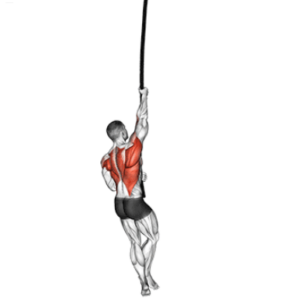

How to Do It:
- You’ll need a sturdy rope, usually 1.5 to 2 inches in diameter, anchored securely from a high point.
- Stand at the base of the rope. Reach up and grab the rope with both hands, using a strong grip.
- Pull yourself up with your hands and arms while simultaneously lifting your legs, and wrap your legs around the rope.
- Start climbing and alternate your hands as you climb higher. Keep your body close to the rope for better control and efficiency.
- Reverse the steps as you start climbing down, and keep your feet in contact with the rope for safety and stability.
- Climb up and down 3-4 times, no additional weight is required.
Tip:
Thick rope increases the challenge to your grip, intensifying the workout for your forearms. This exercise is not for beginners.
7. Plate Pinches – Amazing Grip Strength Builder, Beginner-Friendly

How to Do It:
- Hold two weight plates together with smooth sides out.
- Pinch the plates together using your fingers and thumb.
- Hold for as long as possible.
- Rest and repeat for 3 sets.
Tip
Start with lighter plates and gradually increase the weight as your grip strength improves.
8. Dead Hangs – Improve Your Grip Strength And Decompress Your Spine

Effectiveness:
Dead hang is an amazing exercise for your shoulder health and lower back health in general as it strengthens smaller stabilizing muscles in your shoulder joint/rotator cuff which is arguably the number one approach for shoulder injury prevention, additionally, it decompresses the spine by pulling down on your spine with your entire lower body weight, most of your back muscles are being stretched and lastly, it’s a great forearm exercise since fingers are the only parts of your body that’s holding your entire body weight.
How to Do it:
- Grab the pull-up bar with your hands placed slightly wider than shoulder-width apart.
- Do not engage any muscle of your body, make sure your feet are in the air.
- Hold on to the bar for as long as you can, aim for 20-30 seconds to start with.
- Rest and repeat for 3 sets.
Tip:
No additional weight is required, especially in the beginning, gradually increase the hanging time as your grip strength improves.
Integrating Forearm Exercises into Your Routine
To maximize the benefits of these exercises, incorporate them into your regular workout routine, preferably at the end of every single workout session.
Forearms tend to recover quickly from exercise for several reasons. Firstly, the forearms consist of smaller, more resilient muscles that are accustomed to frequent use in daily activities. These muscles, such as the flexors and extensors, are engaged in repetitive motions throughout the day, whether it’s typing on a keyboard, carrying grocery bags, lifting objects, or gripping. This constant activity enhances their endurance and recovery capabilities.
Secondly, the forearms have a rich supply of blood vessels, ensuring efficient delivery of oxygen and nutrients while removing metabolic waste. This increased blood flow speeds up the repair and recovery process. Additionally, the smaller size of the forearm muscles means they sustain less overall damage compared to larger muscle groups, requiring less recovery time.
Lastly, the neuromuscular adaptations in the forearms are highly efficient. Regular use and specific training can improve neural connections and muscle fiber recruitment, allowing for quicker recovery and readiness for subsequent workouts.
Conclusion
Forearm exercises are a vital component of a balanced fitness routine, offering numerous benefits from improved grip strength to enhanced overall arm aesthetics. By consistently incorporating the exercises listed above into your workouts, you can achieve stronger, more defined forearms. Additionally, get yourself a set of grippers and rubber finger extensors and make a habit of doing a couple of sets with those tools while watching your favorite TV show to get some blood flowing into your forearms and stimulate additional muscle growth. They’re also great for rehabilitation purposes in case of an injury.
